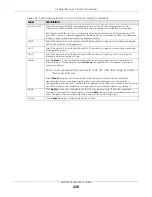
Chapter 27 Loop Guard
XMG1930 Series User’s Guide
233
and reach switch
B
, they are sent back to port
N
on
A
as they are rebroadcast from
B
.
Figure 158
Switch in Loop State
The loop guard feature checks to see if a loop guard enabled port is connected to a Switch in loop
state. This is accomplished by periodically sending a probe packet and seeing if the packet returns on
the same port. If this is the case, the Switch will shut down the port connected to the switch in loop state.
Loop guard can be enabled on both Ethernet ports. The following figure shows a loop guard enabled
port
N
on switch
A
sending a probe packet
P
to switch
B
. Since switch
B
is in loop state, the probe
packet
P
returns to port
N
on
A
. The Switch then shuts down port
N
to ensure that the rest of the network
is not affected by the switch in loop state.
Figure 159
Loop Guard – Probe Packet
The Switch also shuts down port
N
if the probe packet returns to switch
A
on any other port. In other
words loop guard also protects against standard network loops.
The following figure illustrates three switches forming a loop. A sample path of the loop guard probe
packet is also shown. In this example, the probe packet is sent from port
N
and returns on another port.
As long as loop guard is enabled on port
N
. The Switch will shut down port
N
if it detects that the probe
packet has returned to the Switch.
Figure 160
Loop Guard – Network Loop
Note: After resolving the loop problem on your network you can re-activate the disabled port
through the Web Configurator or through commands (See the CLI Reference Guide).
















































